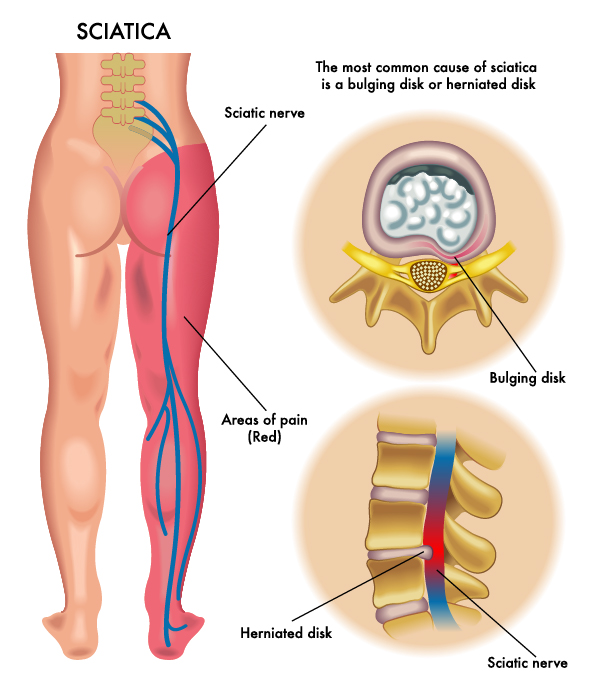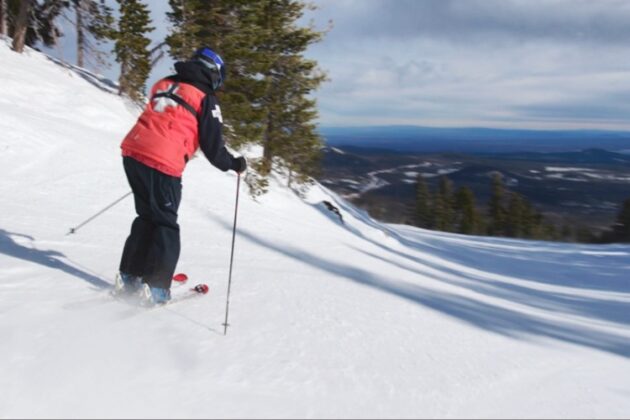
Sciatica is a common type of back pain that can cause sharp, burning, or “pins and needles” sensations that radiate down your legs. This condition can be acute or recurring. It is important to understand what triggers the sciatic nerve so you can help protect your back health and prevent any associated leg pains.
WHAT TRIGGERS THE SCIATIC NERVE?
HERNIATED DISC
 Sciatica is most commonly caused by a slipped or herniated disc. Vertebral discs are flexible, rubbery cushions that support the vertebral bones. Each disc has a jelly-like center (nucleus) that is surrounded by a tough outer ring (annulus). A disc herniates when its nucleus pushes against the outer ring and puts pressure on the sensitive spinal nerves, causing back pain. Because a herniated disc in the low back often puts pressure on the nerve root leading to the leg and foot, pain often occurs in the buttock and down the leg.
Sciatica is most commonly caused by a slipped or herniated disc. Vertebral discs are flexible, rubbery cushions that support the vertebral bones. Each disc has a jelly-like center (nucleus) that is surrounded by a tough outer ring (annulus). A disc herniates when its nucleus pushes against the outer ring and puts pressure on the sensitive spinal nerves, causing back pain. Because a herniated disc in the low back often puts pressure on the nerve root leading to the leg and foot, pain often occurs in the buttock and down the leg.
In most cases, herniated discs can also result from age-related weakening of the spinal discs. This is called disc degeneration, and it can occur gradually over many years as a result of normal wear and tear on the spine.
SPINAL STENOSIS
Spinal stenosis is a condition in which the spinal canal narrows. This puts pressure on the spinal cord and the spinal nerves, leading to sciatic pain. Arthritis is the most common cause of spinal stenosis due to degeneration. Anything that narrows the spinal canal makes the spinal cord and nerves vulnerable to pressure, thus causing irritation and inflammation. It is most common in older adults, resulting from a combination of aging and degeneration of the spine.
When stenosis is located in the lower back, it can also affect posture, gait, and bladder and bowel function. While many patients note some relief when sitting and leaning forward, standing and walking may bring on severe pain and weakness.
POOR POSTURE
Walking or sitting incorrectly can worsen your sciatica symptoms. For example, walking with a hunched back or wearing high heels can cause an imbalance of weight distribution putting pressure on the front of your foot, forcing you to push your pelvis too far forward, and creating sciatic nerve pressure. Wearing proper footwear can greatly reduce your chances of aggravating that area.
In addition, sitting with objects in your back pockets can place pressure on the piriformis muscle which can trigger the sciatic nerve.
TREATMENT
Back pain plagues so many of us that it is now one of the leading causes of disability worldwide, according to the Global Burden of Disease 2010. Taking care of our backs should be a high priority so that we can continue doing the things we love without discomfort.
Various back conditions can require treatment plans from different types of specialists, and The Center’s team of physicians are equipped to treat a variety of back conditions that can occur including sciatica. To find the right specialist for you, click HERE.
NON-SURGICAL
According to the American Academy of Orthopaedic Surgeons, 80-90% of patients with sciatica get better over time without surgery. Non-surgical treatment options can include:
- Anti-inflammatory medicine
- Gentle ice or heat on the affected area
- Avoid being sedentary; careful movement helps to reduce inflammation
- Corticosteroid injections
- Physical therapy
SURGICAL
The Center physicians usually recommend non-surgical options first, but if pain persists after three or more months, you may need surgery. Your neurosurgeon may recommend a laminectomy or lumbar microdiscectomy, one of the most common surgeries to alleviate back pain from ruptured, slipped, or bulging disks if other treatment methods have been tried and failed.
Following treatment for sciatica, you will most likely be able to resume your normal activities pain-free. Although, it is possible that your disc could rupture again.
For more information on back pain, refer to our video provided below. Physiatrist, Mathew Paluck and neurosurgeon, Ray Tien, discuss common causes of back pain, when to see a doctor, and the various conservative and surgical treatment options.





